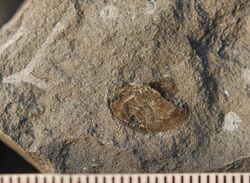Biology:Naiadites
| Naiadites | |
|---|---|

| |
| An internal mould of a Naiadites devonicus from Waterloo Farm lagerstätte | |
| Scientific classification | |
| Domain: | Eukaryota |
| Kingdom: | Animalia |
| Phylum: | Mollusca |
| Class: | Bivalvia |
| Order: | Pteriida |
| Family: | †Myalinidae |
| Genus: | †Naiadites Dawson, 1860 |
Naiadites is an extinct genus of thin-shelled non-marine bivalve from the Upper Carboniferous coal-measures of Nova Scotia in Canada .
Species
The genus contains the following species:
- Naiadites carbonarius[1] from the Pennsylvanian (Upper Carboniferous) of Nova Scotia in Canada
- Naiadites orhallensis from the Carboniferous of Germany
- Naiadites phillipsi[2] from the Westphalian B–C (Lower–Middle Pennsylvanian) of the Ruhr area in western Germany
- Naiadites devonicus[3][4] from the Late Devonian of South Africa
N. orhallensis has been described as occurring in dense colonies attached to floating or submerged stems of terrestrial plant wrack.[5]
Naiadites devonicus, known only from the Waterloo Farm lagerstätte deposit, constitutes the dominant preserved aquatic invertebrate therein, with hundreds of valves having been collected, generally ranging between 10 and 25 mm in length. The palaeoenvironment has been interpreted as being a fresh to brackish water habitat within the palaeoantarctic circle. As this is the earliest known Naiadites, Scholtz and Gess have suggested that it may have spread to lower latitudes following the End Devonian Mass Extinction in response to global cooling, suggesting an origin for post extinction taxa appearing at low palaeolatitudes during the early Carboniferous.[3] Gess and Whitfield have suggested that N. devonicus lived attached to the abundant submerged and floating vegetation at Waterloo Farm. Probably concentrated where river(s) entered the estuarine lake carrying suspended particulate organic matter they were likely rafted on floating vegetation into more saline portions of the system and would have provided an important food source for predatory fishes.[6]
References
- ↑ Dawson, J.W., 1860. Supplementary Chapter to “Acadian Geology”. Oliver & Boyd, Edinburgh.
- ↑ Weier, J., 1959. A Monograph of British Carboniferous Non-marine Lamellibranchia. Part X. Palaeontological Society, London, pp. 273–320.
- ↑ 3.0 3.1 SCHOLTZ, S. & GESS, R. (2017). Oldest known naiaditid bivalve from the high-latitude Late Devonian (Famennian) of South Africa offers clues to survival strategies following the Hangenberg mass extinction. Palaeogeography, Palaeoclimatology, Palaeoecology 471, 31–39.
- ↑ Scholze, Frank; Gess, Robert W. (2021-12-01). "Late Devonian non-marine Naiadites devonicus nov. sp. (Bivalvia: Pteriomorphia) from the Waterloo Farm Lagerstätte in South Africa" (in en). Geobios 69: 55–67. doi:10.1016/j.geobios.2021.07.002. ISSN 0016-6995. https://www.sciencedirect.com/science/article/pii/S0016699521000474.
- ↑ Huwe, S.I., 2006. Die Bivalvenfauna aus dem Namurium B (Pennsylvanium) von Hagen-Vorhalle – Taxonomie, Faunenbeziehungen und Paläoökologie. Geol. Palaeontol. 40, 63–171.
- ↑ Gess, Robert W. and Whitfield Alan K. (2020). "Estuarine fish and tetrapod evolution: Insights from a Late Devonian (Famennian) Gondwanan estuarine lake and a southern African Holocene equivalent". Biological Reviews. doi:10.1111/brv.12590. PMID 32059074
Wikidata ☰ Q102799731 entry
 |

